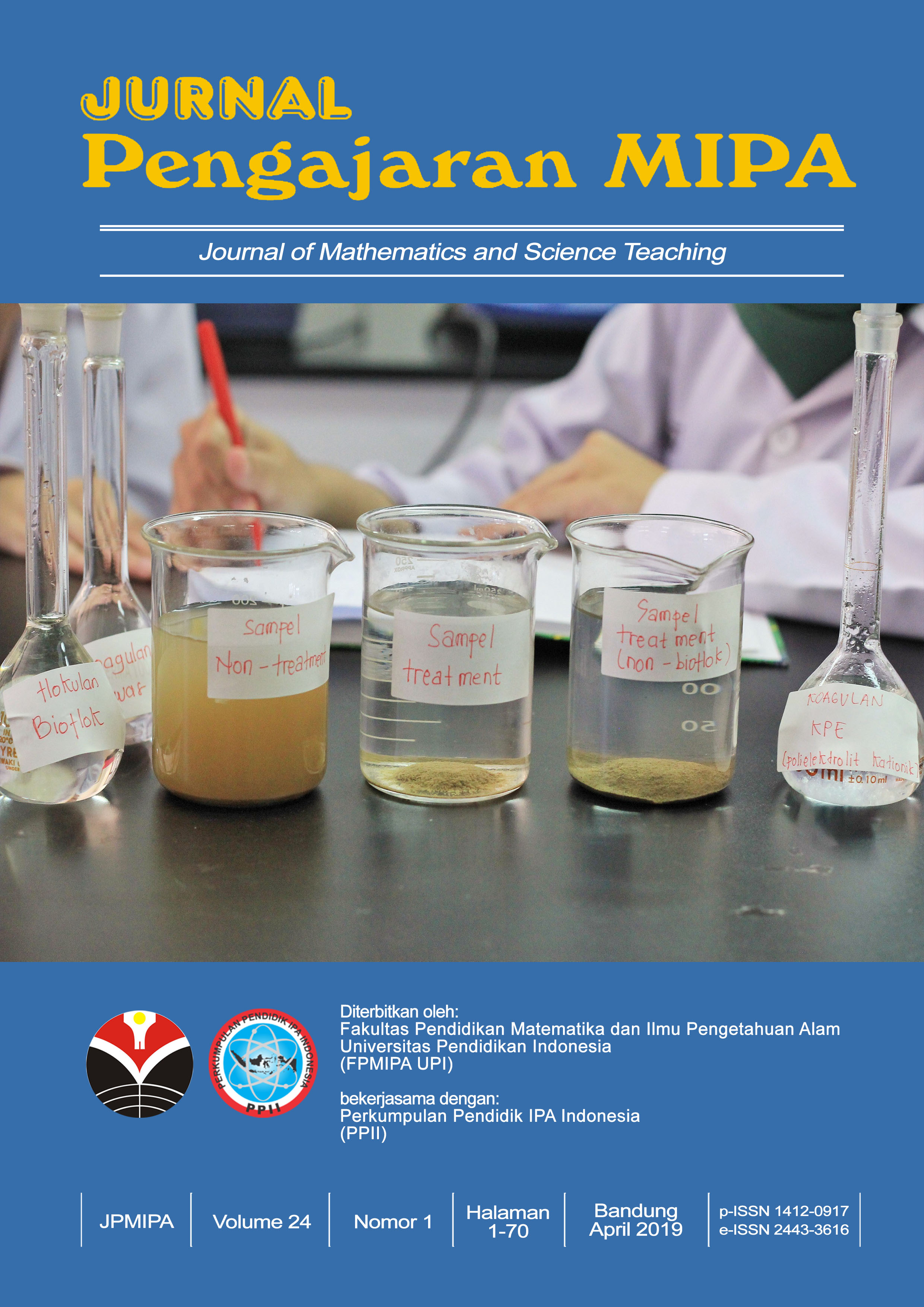KEMAMPUAN MENDESKRIPSIKAN HUBUNGAN ANTAR KONSEP FISIKA SISWA SMP DALAM PEMBELAJARAN BERBASIS FREE INQUIRY DALAM UPAYA MENINGKATKAN KEMAMPUAN GENERIK SAINS
Abstract
Keywords
Full Text:
PDFReferences
Brotosiswoyo,B.S. (2001). Hakikat Pembelajaran Fisika di Perguruan Tinggi. Jakarta: Proyek Pengembangan Universitas Terbuka, Direktorat Jenderal Pendidikan Tinggi, Depdiknas.
Clarke, J.A. and Rowe, E. (2007). Learning science on-line: a descriptive study of online science courses for teachers, Learning Science Online.
Cruickshank D.R. et al (2007) The Act of Teaching, Boston: McGraw-Hill Higher Education.
Corte, Verschaffel, & Green (1994). Learning and instruction of mathematics. In T. Husen & T.N. Postletnwaite (Eds.), In International Encyclopaedia of Education (2nd ed), (pp. 3653-3655). Stockholm & Hamburg: Pargamon.
Crawford, K. & Adler, J. (1996). Teachers as researchers in mathematics education. In Alan J. Bishop et al. (eds.). International Handbook of Mathematics Education. 2, 1187-1206. Dordrecht, The Netherlands: Kluwer Academics Publishers.
De Lange, J. (1996). Using and applying mathematics in education. In A.J. Bishop et al. (eds.). International Handbook of Mathematics Education. 1 (49-97). The Netherlands: Kluwer Academics Publishers.
Downton, Andy (1992): Engineering The Human-Computer Interface, McGraw -Hill Book Company (UK) Limited, Singapore.
Heinich, R. et al (1996). Instructional Media and Technology for Learning, New Jersey: Prentice Hall, Inc.
Hinduan,A.A. dan Liliasari.(2003). Pengembangan model pembelajaran untuk meningkatkan keterampilan mengajar IPA guru SLTP, Penelitian, Hibah Bersaing X/2 DIKTI.
Hinduan, A.A., Wawan S., Parsaoran S., dan Iyon S.(2007). Ilmu dan Aplikasi Pendidikan, Pendidikan Fisika, Pedagogiana Press Bandung.
Hinduan, A., Hidayat, M., & Firman, H. (1995). Overview of Indonesian education. In the Proceeding of International Seminar on Science and Mathematics Education (Comparative Study between Indonesia and Japan) Jakarta and Bandung, (pp.55-68). July, 3-7: JICA-IKIP Bandung.
Koseki, K. (1999). Mathematics education in Japan. In Ijang R., Harun I. , & Wahyu S. (Eds.), Proceding of Seminar on Quality Imrovement of Mathematics and Science Education in Indonesia Bandung, August 11, 1999, (pp 39-46). Bandung: Institute of Teaching and Education Sciences (IKIP).
Mullis, I.V.S, et al (2000). TIMMS 1999, (p. 32). Boston: The International Study Center Boston College, Lynch School of Education.
Munir.(2001) Aplikasi teknologi multimedia dalam proses belajar mengajar, Mimbar Pendidikan, University Press UPI.
NRC.(1996). National Science Education Standards, Washington, DC: National Academy Press.
NSRC (1997) Science for All Children: A Guide to Improving Elementary Science Education in Your School District, Washington, DC: National Academy Press.
Romberg, T.A & Kaput, J.J. (1999). Mathematics worth teaching, mathematics worth understanding. In Elizabeth Fennema & Thomas A. Romberg (Eds.), Mathematics classroom that promote understanding, (pp.3-17). New Jersey: Lawrence Erlbaum Associates Publishers.
Sabandar, J. & Turmudi (2001). Desain dan implementasi pembelajaran matematika dengan pendekatan realistik di SLTP Kota Bandung. Laporan Hasil Penelitian. Jurdikmat, FPIPA, UPI: Tidak dipublikasikan.
DOI: https://doi.org/10.18269/jpmipa.v16i1.36007
Refbacks
- There are currently no refbacks.
Copyright (c) 2021 Jurnal Pengajaran MIPA

This work is licensed under a Creative Commons Attribution-ShareAlike 4.0 International License.
JPMIPA http://ejournal.upi.edu/index.php/jpmipa/index is licensed under a Creative Commons Attribution-ShareAlike 4.0 International License
Jurnal Pengajaran Matematika dan Ilmu Pengetahuan Alam (JPMIPA) or Journal of Mathematics and Science Teaching
All rights reserverd. pISSN 1412-0917 eISSN 2443-3616
Copyright © Faculty of Mathematics and Science Education (FPMIPA) Universitas Pendidikan Indonesia (UPI)
View JPMIPA Stats









